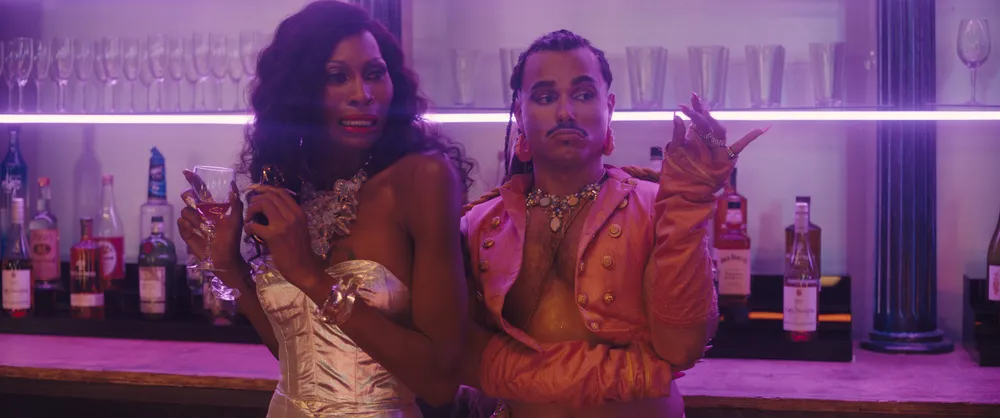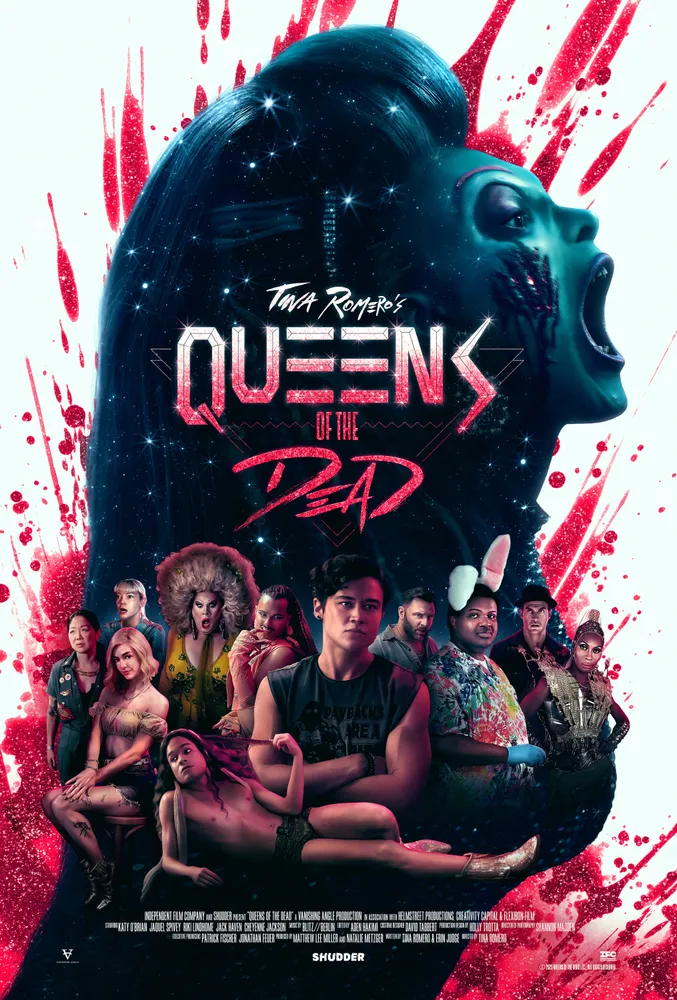Tina Romero didn’t want to make a zombie movie. While her father, George A. Romero, didn’t invent the zombie picture, he certainly codified it into the mainstream of genre cinema with his groundbreaking 1968 underground classic Night of the Living Dead, so it’s understandable his daughter wouldn’t necessarily want to follow in those footsteps, especially in her feature-length debut.
“There definitely [were] a lot of complex thoughts and feelings,” said Romero. “These are big shoes to fill, and I didn’t want to force it.”
And yet that’s exactly where Romero ended up with Queens of the Dead, a flamboyantly larger-than-life Queer smorgasbord of zombie mayhem, wicked one-liners, found-family pathos, and community togetherness that speaks to the here and now, even as it cleverly pays homage to previous “…of the Dead” films.
“I needed an authentic a-ha moment,” explained the filmmaker, “and that’s what I had [with Queens of the Dead]. There was some drama in the Queer-nightlife-promoter scene, and the quote was, ‘When will the Queer community stop devouring its own?’ It smacked me in the face. This is the community I know. These are the characters I could portray. These are the details that I understand. It’s a story I can tell, and that’s what I needed: a story I could tell to get into the sandbox my dad created.”
It was a multicultural, fabulously coifed entry into the genre that Romero couldn’t resist. “Once I knew specifically that the Queer nightlife of New York City was my in, the rest became easy,” she said. “That is my world, and those are my people. The monster? He [George Romero] made that for us already. He set up the rules. Now we get to play with that monster in all the ways, but I knew I wanted to keep very true to his traditions. The monsters needed to be slow. One bite turns you. You got to take out the brain. And then, of course, you need to say some shit when you’re playing with the monster too.”
Social commentary
But all of her father’s films had layers of incisive, hard-hitting social commentary intermixed with all the scares, shocks, and gore. It was imperative that Queens of the Dead do the same. “That was the more difficult part,” admitted Romero. “What social commentary do we want to tackle in our tapestry of all that is wrong with the world? There’s so much to choose from! For [co-screenwriter] Erin Judge and [me], we wanted to do opioids, we wanted to do phone addiction, we wanted to do infighting within the community, and the problem of too much information in the current ecosystem. Who do you trust? Who do you listen to?”
Big questions, but the film tackles them with a deft mixture of intelligence and silliness that’s frequently surprising. But even more shocking is the aura of hope amid all of the carnage Romero infuses into the film’s DNA — not something most would say about George Romero’s zombie epics, especially the timeless trifecta of Night of the Living Dead, Dawn of the Dead, and Day of the Dead. There’s something inherently pessimistic, maybe even nihilistic, about all three.
“I am a bit more of an optimist than my dad was,” admitted Romero. “It was painful for us to kill [some of the characters]; it was not fun for us to do that, but we knew we needed to. We had to tug on some heartstrings. Ultimately, though, we knew wanted to tell a story of Queer survival, and we wanted the bulk of our characters to get through this together, because that is what this is about. It’s about community sticking together.”

The cast
That theme of community sticking together extended to the casting. The filmmaker assembled a diverse ensemble that included the likes of drag superstar Nina West, rising star Katy O’Brian, Nonbinary comedic sensation Jack Haven, Knives Out scene-stealer Riki Lindhome, Gay icon Cheyenne Jackson, and bona fide legend Margaret Cho. Even Tom Savini pops in for a memorable cameo.
“We started casting years before we had a green light,” said Romero, “and I have to credit my producers for encouraging me to do that. I started writing letters to people many, many years before we had any money.
“Dominique Jackson [from Pose] was actually our first ‘yes,’ and what a powerful yes that is… That was hugely helpful. The stars really aligned, and I couldn’t believe how lucky we got. This cast is unbelievable. I keep saying, all queens, no divas. Everyone was so down to do this. It was a family-style, down-and-dirty shoot. It was challenging, It was hot. We had zombie prosthetics. We had Drag. People were sweating… just tough as nails, every single one of them. They brought their whole selves to it.”
With so many comedy and creative heavyweights, the director did have to allow for moments of improvisation, but within a controlled environment. “We would talk beforehand… and we would say that, in this moment, we don’t have time to go off book. We need to be on book,” said Romero.
“But, for example, when Kelsey has an axe in her leg, that was scripted as [lyrics from ‘My Favorite Things’ from The Sound of Music], and my producer was like, ‘You can’t do that.’ So I went to Jack and was like, ‘Can you just improvise some singing?’ And Jack is hilarious and brilliant and such a wierdo. They have this direct line to this creative weirdness, and they did several different versions [of ‘There’s an Axe in My Leg’]. There was an old fisherman version. but the pop version they did was by far the best, and that was all an improv take.”
“One of my favorite moments is when Tomás [Matos] is live-streaming and goes, ‘They’re coming to get you, Barbara,’” added Romero. “Obviously, he was thinking of Night of Living Dead, but that was all improv, and I’m obsessed with that moment… [For] me and Aden [Hakimi], my editor, it was brutal trying to decide what to use. We had so many hilarious buttons to end scenes with, and it really became a dance of how do we split the buttons — the last word — between all the people, because there was just so much gold to choose from.”
The biggest issues revolved around Katy O’Brian. A budding superstar after her transformative turn as Kristen Stewart’s bodybuilding girlfriend in the exhilarating 2024 neo noir Love Lies Bleeding, the actor has gone on to significant appearances in gigantic Hollywood blockbusters like Twisters, Mission: Impossible – The Final Reckoning, and the remake of The Running Man. Even though she was a massive fan of Romero and Judge’s screenplay, keeping her on board the production as the film’s heroic club-owning Lesbian lead Dre wasn’t always a sure thing.
“Katy O'Brian said yes before Love Lies Bleeding, and I remember going to see [it] and writing her a letter afterward saying that [it] was so good and that I hope you still want to do this little movie,” Romero said with a smile. “Katy is so good and so talented. She was actually doing Mission: Impossible – The Final Reckoning at the same time she did Queens of the Dead, which is why there’s a special thanks to Tom Cruise. It looks like a joke, but it’s not. Mission: Impossible flew her on their dime back to our set three times, and [Katy] was just down to do it!”

Divine intervention?
The filmmaker has to pinch herself sometimes that all of this is happening right now. More than that, though, Romero’s equally cognizant of how important a national theatrical release for Queens of the Dead is during this current cultural and political moment.
“It’s so special,” said the director. “I’m almost speechless. The way [this] came together feels like there some divine intervention. The fact we got it done so quickly. The fact that IFC is willing to put it out on a big screen this year feels major, because so often you take something like this to a festival and it’s like two, three years before you see a release. Right now! Not even just in a year of a Kesha comeback, but also in a year when this shit has been so bad. Our community is feeling so afraid that they feel the need to hide, that they are being erased, and I love that this [film] is like, nope! We are out here and we’re going to have fun, and we’re going to fight zombies, and we’re going to be colorful — just try not to love us!”
Romero briefly paused before continuing: “I feel incredibly proud to take the George Romero zombie film and make it Gay,” she confessed. “We’re here! What are you going to do about it? And, we’re all here, it’s all of us. One person doesn’t have to carry the weight of survival for the entire Queer community. Everybody’s here. This really was a film made by Queer people very much for Queer people. But I hope everybody comes to the party. Maybe people who wouldn’t normally go to a drag show might go to this movie and come out feeling a bit more empathy.”
Support the Seattle Gay News: Celebrate 51 Years with Us!
As the third-oldest LGBTQIA+ newspaper in the United States, the Seattle Gay News (SGN) has been a vital independent source of news and entertainment for Seattle and the Pacific Northwest since 1974.
As we celebrate our 51st year, we need your support to continue our mission.
A monthly contribution will ensure that SGN remains a beacon of truth and a virtual gathering place for community dialogue.
Help us keep printing and providing a platform for LGBTQIA+ voices.
How you can donate!
Using this link: givebutter.com/6lZnDB
Text “SGN” to 53-555
Or Scan the QR code below!



